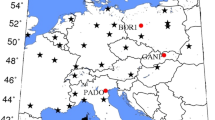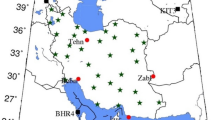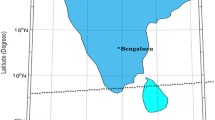Abstract
The total electron content (TEC) is one of the most important parameters for studying the behavior of the ionosphere. The global ionosphere maps (GIMs) can be used to study the TEC time series variations. The time resolution of the GIM-TEC is 2 h, whereas the frequency of the ionospheric temporal behavior can be less than 2 h. To solve this problem, we present a new method for ionosphere time series modeling and prediction in Iran. The adaptive neuro-fuzzy inference system (ANFIS) and principal component analysis are combined to model the TEC of the ionosphere. In fact, the observations are decomposed into principal components before entering to the ANFIS network and only a few main components are used for training the network. The main advantage of this combination is to increase the accuracy of the results and reduce the time of convergence to achieve an optimal solution. To evaluate the proposed method, we used observations of a Tehran GNSS station in 2016 and 2017. The root-mean-square error, correlation coefficient, and dVTEC = |VTECGPS − VTECmodel| were used to assess the accuracy of the proposed method. Also, all results are compared with the International Reference Ionosphere 2016 (IRI2016), GIM-TEC, and artificial neural networks (ANNs) ionosphere models. The results indicate a 1 to 4.72 TECU improvement in the temporal resolution of TEC modeling with the proposed method, compared to the IRI2016, GIM, and ANNs in the Iranian region.










Similar content being viewed by others
References
Cander R (1998) Artificial neural network applications in ionospheric studies. Ann Geofis 41(5–6):757–766
Ciraolo L, Azpilicueta F, Brunini C, Meza A, Radicella SM (2007) Calibration errors on experimental Slant Total Electron Content (TEC) determined with GPS. J Geodesy 81(2):111–120
Ghaffari Razin MR (2015) Development and analysis of 3D ionosphere modeling using base functions and GPS data over Iran. Acta Geod Geophys 51(1):95–111
Ghaffari Razin MR, Voosoghi B (2017) Ionosphere tomography using wavelet neural network and particle swarm optimization training algorithm in Iranian case study. GPS Solut 21(3):1301–1314
Ghaffari Razin MR, Voosoghi B, Mohammadzadeh A (2015) Efficiency of artificial neural networks in map of total electron content over Iran. Acta Geod Geophys 51(3):541–555
Habarulema JB, McKinnell L-A, Opperman BDL (2009) A recurrent neural network approach to quantitatively studying solar wind effects on TEC derived from GPS; preliminary results. Ann Geophys 27(11):2111–2125
Hernández-Pajares M, Juan J, Sanz J (1999) New approaches in global ionospheric determination using ground GPS data. J Atmos Sol Terr Phys 61:1237–1247
Hernández-Pajares M, Juan J, Sanz J, Orus R, Garcia-Rigo A, Feltens J, Komjathy A, Schaer S, Krankowski A (2009) The IGS VTEC maps: a reliable source of ionospheric information since 1998. J Geodesy 83:263–275
Hirooka S, Hattori K, Takeda T (2011) Numerical validations of neural-network-based ionospheric tomography for disturbed ionospheric conditions and sparse data. Radio Sci 46(05):1–13
Jackson JE (2003) A users’ guide to principal components. Wiley, London
Komjathy A, Langley R. B (1996) An assessment of predicted and measured ionospheric total electron content using a regional GPS network. In: Proceedings of ION NTM 1996, Institute of Navigation, Santa Monica, CA, January 22–24, pp 615–624
Leandro RF, Santos MC (2007) A neural network approach for regional vertical total electron content modeling. Stud Geophys Geod 51(2):279–292
Liu Z (2004) Ionospheric tomographic modeling, UCGE Reports, Number 20198, University of Calgary
Liu Z, Gao Y (2003) Ionospheric TEC predictions over a local area GPS reference network. GPS Solut 8(1):23–29
Ma XF, Maruyama T, Ma G, Takeda T (2005) Three dimensional ionospheric tomography using observation data of GPS ground receivers and ionosonde by neural network. J Geophys Res 110(A05308):1–12
Mallika I, Ratnam D, Sivavaraprasad G, Raman S (2019) Implementation of hybrid ionospheric TEC forecasting algorithm using PCA-NN method. IEEE J Sel Top Appl Earth Observ Rem Sens 12(1):371–381
Mannucci A, Wilson B, Yuan D, Ho C, Lindqwister U (1998) Runge T (1998) Global mapping technique for GPS-derived ionospheric total electron content measurements. Radio Sci 33:565–582
Saito A, Teraishi S, Ueno G, Fujita N, Tsugawa T (2007) GPS ionospheric tomography over Japan with constrained least‐squares method. Eos Trans AGU 88(52), Fall Meet. Suppl., Abstract SA13A-1061
Schaer S (1999) Mapping and predicting the earths ionosphere using the global positioning system. Ph.D. dissertation, Astronomical Institute, University of Berne, Switzerland, 205
Schalkoff RJ (1997) Artificial neural networks, vol 1. McGraw-Hill, New York
Sekido M, Kondo T, Kawai E, Imae M (2003) Evaluation of GPS based ionospheric TEC map by comparing with VLBI data. Radio Sci 38(4):1069. https://doi.org/10.1029/2000RS002620
Strangeways HJ et al (2009) Near-earth space plasma modeling and forecasting. Ann Geophys 52(3–4):255–271
Walker JK (1989) Spherical cap harmonic modeling of high latitude magnetic activity and equivalent sources with sparse observations. J Atmos Terr Phys 51(2):67–80
Wen D, Wang Y, Norman R (2012) A new two-step algorithm for ionospheric tomography solution. GPS Solut 16(1):89–94
Yao Y, Chen P, Zhang S, Chen J (2013) A new ionospheric tomography model combining pixel-based and function-based models. Adv Space Res 52(4):614–621
Yao Y, Tang J, Kong J (2015) New ionosphere tomography algorithm with two-grid virtual observations constraints and three-dimensional velocity profile. IEEE Trans Geosci Remote Sens 53(5):2373–2383
Yin P, Mitchell CN, Spencer PSJ, Foster JC (2004) Ionospheric electron concentration imaging using GPS over the USA during the storm of July 2000. Geophys Res Lett 31:L12806
Yizengaw E, Moldwina MB, Dysonb PL, Essexb EA (2006) Using tomography of GPS TEC to routinely determine ionospheric average electron density profile. J Atmos Solar Terr Phys 69(3):314–321
Zadeh LA (1996) Fuzzy sets. Inf Control 8:338–353
Zhang JR, Zhang J, Lok T, Lyu M (2007) A hybrid particle swarm optimization–back-propagation algorithm for feed forward neural network training. Appl Math Comput 185(2007):1026–1037
Zheng D, Hu W, Nie W (2015) Multiscale ionospheric tomography. GPS Solut 19:579–588
Acknowledgements
The International GNSS Service is acknowledged for providing the data used in this study. The anonymous reviewers are thanked for their constructive comments.
Author information
Authors and Affiliations
Corresponding author
Additional information
Publisher's Note
Springer Nature remains neutral with regard to jurisdictional claims in published maps and institutional affiliations.
Rights and permissions
About this article
Cite this article
Ghaffari Razin, M.R., Voosoghi, B. Ionosphere time series modeling using adaptive neuro-fuzzy inference system and principal component analysis. GPS Solut 24, 51 (2020). https://doi.org/10.1007/s10291-020-0964-6
Received:
Accepted:
Published:
DOI: https://doi.org/10.1007/s10291-020-0964-6




